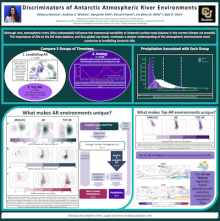Discrimintators of Antarctic Atmospheric River Environments
Rebecca
Baiman
University of Colorado Boulder - Department of Atmospheric and Oceanic Sciences
Poster
Although rare, atmospheric rivers (ARs) substantially influence Antarctic surface mass balance interannual variability. Here, we identify environmental characteristics unique to AR environments by comparing (1) AR, (2) Analog (environments that feature high-low pressure couplets, similar to AR environments, but no AR), and (3) high-precipitation AR timesteps during 1980–2017 around Antarctica. We find significant differences between AR and Analog environments that include more intense and poleward-shifted mid-tropospheric geopotential height couplets as well as larger atmospheric moisture anomalies. We find similar significant enhancement in synoptic-scale dynamic drivers of Top ARs compared to AR environments, but no significant difference in local integrated water vapor anomalies. Instead, our results highlight the importance of large-scale dynamics driving more substantial AR impacts, including connections between high-precipitation ARs and Rossby waves excited by tropical convection. This deeper understanding of environments conducive to ARs provides context for interpreting future changes to the Antarctic surface mass balance.

Poster file
Baiman_Rebecca_blocking_poster.pdf
(7.98 MB)
Meeting homepage
